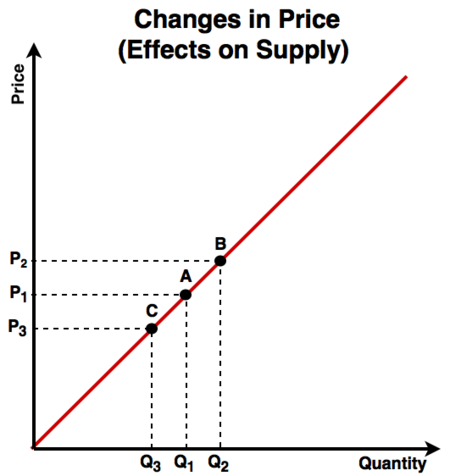Supply
Supply and demand are market forces that interact to determine the price and quantity of goods and services that are bought and sold in a market. Supply is the total amount of a good or service that the producers in a market are willing to sell. Demand refers to the total amount of a good or service that all the buyers in a market are willing to purchase.[1] Both of these forces in the market respond to and together, they shape the price of a good or service in a market.
Supply
Supply is: "the quantity of a good or service that producers are willing to provide at the specified price, time period, and condition of sale".[2]
The supply side of a market is influenced by a number of factors, price helps determine how much will be produced, if a price is high then producers will produce more of a good to take advantage of high prices. Conversely, if prices are low then producers will be discouraged from producing a large quantity of the good.[1]
The price of what goes into manufacturing a good (production cost) and the technology used also affect the supply. If a manufacturer is producing solar panels at a cost of $35 per unit and over time new semiconductor manufacturing technology is developed making them cheaper to produce, then the overall price will fall and the producer will be able to manufacture a larger quantity.
The number of sellers at a market will also increase the supply, conversely if there are fewer producers, then the supply will drop because one firm cannot produce the same amount as multiple firms without a larger expansion over time.
Price Changes and the Effect on Supply

Figure 1. shows how changes in the price for a product affects the quantity of a good supplied to a market.
- At Point A the price of the good is P1 and the quantity supplied is Q1
- There are a number of reasons why the price changes, see price and demand, but some factor causes the price in the market to change.
- If the price for the good falls to P3 then the quantity supplied will also decrease to Q2. This is Point C on the supply curve.
- If the price for the good rises to P2 then the quantity supplied will also increase to Q2. This is Point B on the supply curve.
Shifts in Supply

Factors that "shift" the supply in a market are factors other than price. For example, if an advancement in technology makes it cheaper to produce a good or service than the supply will increase because it is cheaper to produce.[5]
Another factor could cause the supply to shift and decrease the supply to the market. For example, I the cost of production rises because raw materials are more expensive then the quantity supplied will be less because the product is more expensive to produce.
Shifts affect the total quantity (TQ) supplied to a market. See how shifts affect the market in Figure 2.
- The total supply for S1 is TQ1, the maximum amount of the good that could be supplied to the market is TQ1.
- If a factor causes a shift that increases the supply to S2 then the total quantity available is TQ2.
- Another increase would result in an increase to TQ3
If the demand for the good is more than TQ3 then there will be a shortage as there is not enough of the good to satisfy every consumer that wants it.
For example, during the Oil crisis of the 1970s there was not enough gasoline for every consumer who wanted it. In that case, the demand for gasoline exceeded or outstripped the supply of gasoline.
Supply Choke Point
The supply choke point is the price below which, the producer will not sell their good. The supply choke point is where the supply curve intersects the Y-axis. Assume that the supply of a good in a market is S2 in Figure 2. The supply choke point is P2, the firm will not sell the good for any price below that point.[6]
See Also
References
- ↑ 1.0 1.1 A. Goolsbee, S. Levitt and C. Syverson. Microeconomics. New York: Worth Publishers, 2013, pp. 15.
- ↑ C. Park. "Supply." [Online], Available: http://www.oxfordreference.com/view/10.1093/acref/9780198609957.001.0001/acref-9780198609957-e-7987?rskey=ER6mri&result=1, 2012 [Sep 3, 2016].
- ↑ Created internally by a member of the Energy Education team
- ↑ Created internally by a member of the Energy Education team
- ↑ D. Besanko and R. Braeutigam. Microeconomics. Hoboken: Wiley, 2011, pp. 61-63.
- ↑ A. Goolsbee, S. Levitt and C. Syverson. Microeconomics. New York: Worth Publishers, 2013, pp. 24.

